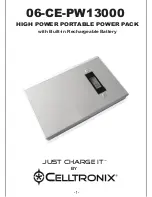
©Copyright Amkus Rescue Systems, Inc. 2016-2017
LAI-001 August 31, 2017 Rev01
12
6.3 CUTTING
A slight rotation of the control valve actuator runs just the electric motor and pump. Rotating the control valve actuator regulates the
hydraulic fl ow rate and power delivered to the tool. Rotating the control valve actuator to the end stops provides maximum hydraulic
fl ow rate and power.
Figure 6.3a
To perform a cutting operation, open the cutter blades. Place the blades around the object to be cut. Close the blades to cut the
object. Maximum cutting forces are obtained nearest the pivot point when possible. Start the cut with the blades engaged as deep
as possible. After making the cut, open the blades and remove the tool. When operating the cutter, take care to be positioned to
the side of the cutter. As the cutter blades meet resistance, the rescue tool may rotate (drift). If tool rotation places the user or
others in jeopardy, immediately release the control valve actuator. The deadman safety feature of the control valve actuator should
immediately return the control valve actuator to the center (neutral) position, and the movement of the blades will stop. Reposition
cutter as needed to maintain optimum cutting performance.
The blades on AMKUS cutters have been proven eff ective for cutting steering columns, brake pedals, latching mechanisms, and
other such items as may be necessary for extrication. However, this cutter is not intended as a piercing tool for heavy metal.
Therefore, when cutting, care must be taken to insure that the tips of the blades have a clear path of travel. The tips of the blades
will pierce the sheet metal body panels of most automobiles, but care must be taken to avoid obstacles like the heavy metal backing
plates behind seat belt mounts, door hinges, and latching mechanisms or locks. Please note that the blades are not unbreakable, and
should not be used to cut hardened items such as tie rods, leaf springs or spindles. Attempting to cut such items may cause damage
to the blades that could result in blade failure.
NOTICE
Blades can break if positioned incorrectly. If blades start to fl ex sideways (tool rolls as space
between blades increases), stop immediately and reconsider cutting strategies.
CORRECT POSITIONING
Figure 6.3b
INCORRECT POSITIONING
Blades start to flex sideways
Figure 6.3c






































